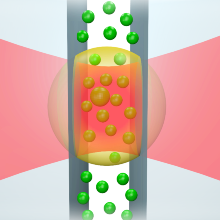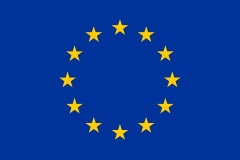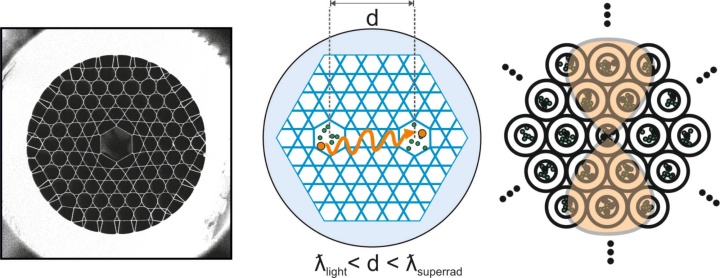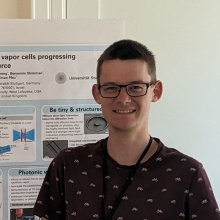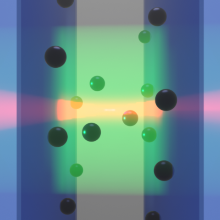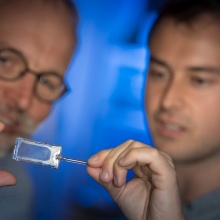Learn about...
The Project
Thermal atoms in confined geometries can strongly interact with photons. By the choice of micrometer-sized glass cells, hollow-core fibers, and waveguides on chips, we stress different facets of confined geometries and implement non-linear quantum effects like four-wave mixing, strong Rydberg-Rydberg interactions, and strong cooperativities that occur at photonic interactions with thermal alkali atoms.
With these endeavors we aim at photonic platforms that are highly integrable and scalable while being at the same time reproducible with high fidelity. We envision a benefit for future quantum technologies, like quantum computing, quantum communication, and quantum metrology.
Deterministic single photons from thermal Rydberg atoms
This project aims at a deterministic single photon source that is reproducible and scalable. Our atomic source directly offers intrinsic center frequency and bandwidth stability and can be scaled up to large arrays at minimal technical overhead. The emission of single photons is enabled by strong Rydberg-Rydberg interactions that realize strong correlations in the atomic medium and block multiple excitations at a time.
So far, we could demonstrate that it is possible to excited thermal atoms in a micrometer-sized vapor cell (µ-cell) to Rydberg states with long coherence times and sufficiently long population storage. We were also able to observe coherent dynamics on nanosecond timescales and could then switch on strong Rydberg-Rydberg interactions. Within a four-wave mixing scheme we could retrieve single photons with anti-bunched light statistics from a thermal atomic volume of the size of one cubic micrometer.
The current goal of this project on the one hand is to turn this emitter into a high-performance device based on leading-edge laser technologies at high repetition rates as well as to integrate the high-NA optics into the µ-cell by means of solid-immersion lenses. On the other hand, relevant physical processes such as Rydberg-Rydberg and Rydberg-wall interaction have to be investigated more in depth. Finally, we aim with this device at applications in the field of quantum information science.
Alkali metal filled hollow-core fibers for generating a bright single-photon source
This goal of this project is to develop a highly efficient source of heralded single photons with a high spectral brightness, based on four-wave mixing in an alkali-vapor contained in a hollow core optical fiber. Hollow-core optical fibers filled with atomic media are known to boost a variety of non-linear optical phenomena including four-wave mixing. This should allow lower pump laser powers to be used which in turn means simple diode lasers could be used to generate the photon pairs. Also, using a thermal vapor with fiber optics should allow for an easily integrated device for many applications requiring heralded single photons.
We use hollow-core fibers encased by alkali-metal-filled glass vapor cells. This setup allows the fibers to be filled simply by diffusion. In this way we can achieve desired optical depths without the use of extra desorption lasers.
A major challenge in this project is to split the photon pairs from each other. Since the photon pairs have the same polarization and spatial mode, and also have very similar frequencies, their separation is difficult using conventional techniques. However, we have developed an atomic Faraday beam splitter effective for this purpose. By using computational optimisation to efficiency guide experimental efforts, we have created an atomic Faraday dichroic beam splitter of unprecedented performance in spectral selectivity.

Interfacing thermal atoms with integrated Photonics
The integration of nanophotonics and atomic physics has been a long-standing goal that would open new frontiers in various disciplines of physics, ranging from laser physics to quantum many-body physics. Accomplishing this goal requires conquering various challenges in nanofabrication and atomic-state manipulation.
Motivated by the promise and potential of this flourishing research direction, our group explores the hybrid systems of atomic vapors and nanodevices. We are interested in investigating cavity quantum electrodynamics (cQED) features that could be achieved in such systems. Moreover, we will study the novel and almost unexplored realm of cQED with highly excited atoms, i.e., Rydberg atoms, which show strong non-linearity at the single-photon level.
At the heart of our experimental setup, we have well-designed nanophotonic devices embedded in glass cells filled with thermal rubidium vapor. Figure 1 shows some of the photonic devices, including ridge waveguides and ring resonators, which we are currently studying in our lab.
The results of our study provide insight into atom-light interaction at sub-wavelength dimensions and pave the way towards realizing novel devices based on atom spectroscopy.
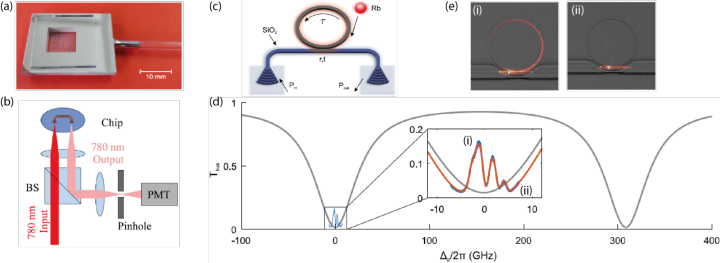
Project Publications
2025
- D. R. Häupl, C. R. Higgins, D. Pizzey, J. D. Briscoe, S. A. Wrathmall, I. G. Hughes, R. Löw, N. Y. Joly, Modelling spectra of hot alkali vapour in the saturation regime, New Journal of Physics 27, 33003 (2025).
2024
- M. Mäusezahl, F. Munkes, R. Löw, Tutorial on laser locking techniques and the manufacturing of vapor cells for spectroscopy, New Journal of Physics 26, 105002 (2024).
- H. Alaeian, A. Skljarow, S. Scheel, T. Pfau, R. Löw, Manipulating the dipolar interactions and cooperative effects in confined geometries, New Journal of Physics 26, 55001 (2024).
- J. A. P. Reuter, M. Mäusezahl, F. Moumtsilis, T. Pfau, T. Calarco, R. Löw, M. M. Müller, Analyzing the collective emission of a Rydberg-blockaded single-photon source based on an ensemble of thermal atoms, Phys. Rev. A 109, 13705 (2024).
- M. Schmidt, S. Bohaichuk, V. Venu, F. Christaller, C. Liu, F. Ripka, H. Kübler, J. P. Shaffer, Rydberg-atom-based radio-frequency sensors: amplitude-regime sensing, Optics Express 32, 27768 (2024).
2023
- S. M. Bohaichuk, F. Ripka, V. Venu, F. Christaller, C. Liu, M. Schmidt, H. Kübler, J. P. Shaffer, Three-photon Rydberg-atom-based radio-frequency sensing scheme with narrow linewidth, Phys. Rev. Appl. 20, L061004 (2023).
2022
- A. Skljarow, H. Kübler, C. S. Adams, T. Pfau, R. Löw, H. Alaeian, Purcell-enhanced dipolar interactions in nanostructures, Phys. Rev. Research 4, 23073 (2022).
- T. Krehlik, A. Stabrawa, R. Gartman, K. T. Kaczmarek, R. Löw, A. Wojciechowski, Zeeman optical pumping of <sup>87</sup>Rb atoms in a hollow-core photonic crystal fiber, Optics Letters 47, 5731 (2022).
- F. Christaller, M. Mäusezahl, F. Moumtsilis, A. Belz, H. Kübler, H. Alaeian, C. S. A. Adams, R. Löw, T. Pfau, Transient dipolar interactions in a thin vapor cell, Physical Review Letters 128, 173401 (2022).
- D. R. Häupl, D. Weller, R. Löw, N. Y. Joly, Spatially resolved spectroscopy of alkali metal vapour diffusing inside hollow-core photonic crystal fibres, New Journal of Physics 24, 113017 (2022).
2021
- I. Caltzidis, H. Kübler, T. Pfau, R. Löw, M. A. Zentile, An atomic Faraday beam splitter for light generated from pump degenerate four-wave mixing in a hollow-core photonic crystal fiber, Phys. Rev. A 103, 43501 (2021).
- F. Davidson-Marquis, J. G. Esteban Gomez-Lopez, B. Jang, T. Kroh, C. Müller, M. Ziegler, S. A. Maier, H. Kübler, M. A. Schmidt, O. Benson, Coherent interaction of atoms with a beam of light confined in a light cage, Light: Science & Applications 10, 114 (2021).
- H. Alaeian, G. Giedke, I. Carusotto, R. Löw, T. Pfau, Limit cycle phase and Goldstone mode in driven dissipative systems, Phys. Rev. A 103, 13712 (2021).
2020
- A. Skljarow, N. Gruhler, W. Pernice, H. Kübler, T. Pfau, R. Löw, H. Alaeian, Integrating two-photon nonlinear spectroscopy of rubidium atoms with silicon photonics, Opt. Express 28, 19593–19607 (2020).
- H. Alaeian, R. Ritter, M. Basic, R. Löw, T. Pfau, Cavity QED based on room temperature atoms interacting with a photonic crystal cavity: a feasibility study, Applied Physics B 126, 25 (2020).
- O. de Vries, M. Plötner, F. Christaller, H. Zhang, A. Belz, B. Heinrich, H. Kübler, R. Löw, T. Pfau, T. Walbaum, T. Schreiber, A. Tünnermann, Highly customized 1010 nm, ns-pulsed Yb-doped fiber amplifier as a key tool for on-demand single-photon generation, Opt. Express 28, 17362–17373 (2020).
- H. Dobbertin, R. Löw, S. Scheel, Collective dipole-dipole interactions in planar nanocavities, Phys. Rev. A 102, 31701 (2020).
2019
- H. Alaeian, C. W. S. Chang, M. V. Moghaddam, C. M. Wilson, E. Solano, E. Rico, Creating lattice gauge potentials in circuit QED: The bosonic Creutz ladder, Phys. Rev. A 99, 53834 (2019).
2018
- R. Ritter, N. Gruhler, H. Dobbertin, H. Kübler, S. Scheel, W. Pernice, T. Pfau, R. Löw, Coupling Thermal Atomic Vapor to Slot Waveguides, Phys. Rev. X 8, 21032 (2018).
2017
- D. Weller, A. Yilmaz, H. Kübler, R. Löw, High vacuum compatible fiber feedthrough for hot alkali vapor cells, Appl. Opt. 56, 1546–1549 (2017).
- J. Schmidt, P. Schalberger, H. Baur, R. Löw, T. Pfau, H. Kübler, N. Frühauf, A transimpedance amplifier based on a LTPS process operated in alkali vapor24th (2017) (available at http://ieeexplore.ieee.org/document/8006156).
- G. Epple, N. Y. Joly, T. G. Euser, P. St. J. Russell, R. Löw, Effect of stray fields on Rydberg states in hollowcore PCF probed by higher-order modes, Optics Letters 42, 3271–3274 (2017).
- J. Gutekunst, D. Weller, H. Kübler, J. Negel, M. A. Ahmed, T. Graf, R. L. A. O. Vol. 56, I. 21, pp. 5.-5. (2017), Fiber-integrated spectroscopy device for hot alkali vapor, Appl. Opt. 56, 5898–5902 (2017).
2016
- Y. Chen, F. Ripka, R. Löw, T. Pfau, Pulsed Rydberg four-wave mixing with motion-induced dephasing in a thermal vapor, Appl. Phys. B 122:18, 1–6 (2016).
- C. Veit, G. Epple, H. Kübler, T. G. Euser, P. St. J. Russell, R. Löw, RF-dressed Rydberg atoms in hollow-core fibres, Journal of Physics B: Atomic 49, 134005 (2016).
- H. Q. Fan, S. Kumar, H. Kübler, J. P. Shaffer, Dispersive radio frequency electrometry using Rydberg atoms in a prism-shaped atomic vapor cell, Journal of Physics B: Atomic 49, 104004 (2016).
- R. Ritter, N. Gruhler, W. H. P. Pernice, H. Kübler, T. Pfau, R. Löw, Coupling thermal atomic vapor to an integrated ring resonator, New Journal of Physics 18, 103031 (2016).
2015
- R. Ritter, N. Gruhler, W. Pernice, H. Kübler, T. Pfau, R. Löw, Atomic vapor spectroscopy in integrated photonic structures, Appl. Phys. Lett. 107, 41101 (2015).
- A. Urvoy, F. Ripka, I. Lesanovsky, D. Booth, J. P. Shaffer, T. Pfau, R. Löw, Strongly Correlated Growth of Rydberg Aggregates in a Vapor Cell, Phys. Rev. Lett. 114, 203002 (2015).
2014
- S. M. Ulrich, S. Weiler, M. Oster1, M. Jetter, A. Urvoy, R. Löw, P. Michler, Spectroscopy of the D1 transition of cesium by dressed-state resonance fluorescence from a single (In,Ga)As/GaAs quantum dot, Phys. Rev. B 90, 125310 (2014).
- B. Huber, A. Kölle, T. Pfau, Motion-induced signal revival in pulsed Rydberg four-wave mixing beyond the frozen-gas limit, Phys. Rev. A 90, 53806 (2014).
- G. Epple, K. S. Kleinbach, T. G. Euser, N. Y. Joly, T. Pfau, P. St. J. Russell, R. Löw, Rydberg atoms in hollow-core photonic crystal fibres, Nature Communications 5, 4132 (2014).
- W. Kiefer, R. Löw, J. W. &. I. Gerhardt, Na-Faraday rotation filtering: The optimal point, Scientific Reports volume 4, 6552 (2014).
2013
- M. M. Müller, A. Kölle, R. Löw, T. Pfau, T. Calarco, S. Montangero, Room temperature Rydberg Single Photon Source, Phys. Rev. A 87, 53412 (2013).
- A. Urvoy, C. Carr, R. Ritter, C. S. Adams, K. J. Weatherill, R. Löw, Optical coherences and wavelength mismatch in ladder systems, J. Phys. B: At. Mol. Opt. Phys. 46, 245001 (2013).
- T. Baluktsian, B. Huber, R. Löw, T. Pfau, Evidence for strong van der Waals-type Rydberg-Rydberg interaction in thermal vapor, Phys. Rev. Lett. 110, 123001 (2013).
2012
- A. Kölle, G. Epple, H. Kübler, R. Löw, T. Pfau, Four-wave mixing involving Rydberg states in a thermal vapor cell, Phys. Rev A 85, 63821 (2012).
2011
- B. Huber, T. Baluktsian, M. Schlagmüller, A. Kölle, H. Kübler, R. Löw, T. Pfau, GHz Rabi flopping to Rydberg states in hot atomic vapor cells, Phys. Rev. Lett. 107, 243001 (2011).
- J. Honer, R. Löw, H. Weimer, T. Pfau, H. P. Büchler, Artificial atoms can do more than atoms: Deterministic single photon subtraction from arbitrary light fields, Phys. Rev. Lett. 107, 93601 (2011).
2010
- T. Baluktsian, C. Urban, T. Bublat, H. Giessen, R. Löw, T. Pfau, Fabrication method for microscopic vapor cells for alkali atoms, Opt. Lett. 35, 1950 (2010).
- H. Kübler, J. P. Shaffer, T. Baluktsian, R. Löw, T. Pfau, Coherent excitation of Rydberg atoms in micrometre-sized atomic vapour cells, Nature Photonics 4, 112 (2010).
We are looking for motivated new team members!
Joint Ph.D. position: The Max-Planck Institute for the Science of Light (Erlangen) and the University of Stuttgart
The goal of this thesis is to study optical non-linearities of strongly interacting Rydberg atoms inside hollow-core photonic crystal fibres. Especially the sensitivity of Rydberg atoms to microwave and THz radiation makes this a promising system for sensing applications. The prospective student will develop new types of hollow core fibres adapted to the properties of Rydberg atoms in Erlangen. The spectroscopy of Rydberg atoms inside these fibres will be carried out in Stuttgart.
By working in Erlangen and in Stuttgart the PhD student will acquire expertise in the field of photonic crystal fibres, in atomic spectroscopy and Rydberg physics. The concept of a joint PhD student Erlangen/Stuttgart has already been implemented successfully.
G. Epple, K. S. Kleinbach, T. G. Euser, N. Y. Joly, T. Pfau, P. St. J. Russell and R. Löw, "Rydberg atoms in hollow-core photonic crystal fibres", Nature Communications 5, 4132 (2014)
Joint Ph.D. position: The Hebrew University of Jerusalem and the University of Stuttgart
Cavity QED is a basis for quantum information processing and devices. In order to transform these ideas into practical room temperature devices we investigate atomic vapor cells in combiantion with integrated light fields. The goal of this thesis is to study the coupling of thermal vapours to the evanescent field of photonic waveguides and resonators. We want to study the coupling of room temperature Rubidium atoms to nanoscopic resonators towards the strong coupling regime. The prospective student will develop new types of photonic structures in Jerusalem and perform the measurements on the atom-light coupling in Stuttgart.
By working in Jersualem and Stuttgart the PhD student will acquire expertise in atomic spectroscopy, nano-photonics and nano-structuring.
R. Ritter, N. Gruhler, W. Pernice, H. Kübler, T. Pfau and R. Löw, "Atomic vapor spectroscopy in integrated photonic structures” Appl. Phys. Lett. 107, 041101 (2015)
L. Stern, B. Desiatov, I. Goykhman and U. Levy, “Nanoscale light–matter interactions in atomic cladding waveguides”,
Nature Communications 4 1548 (2013)
Project Team
Project News
Contact

Robert Löw
Deputy Director
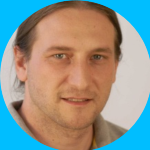
Harald Kübler
Head of Physics Laboratory I / Group Leader


